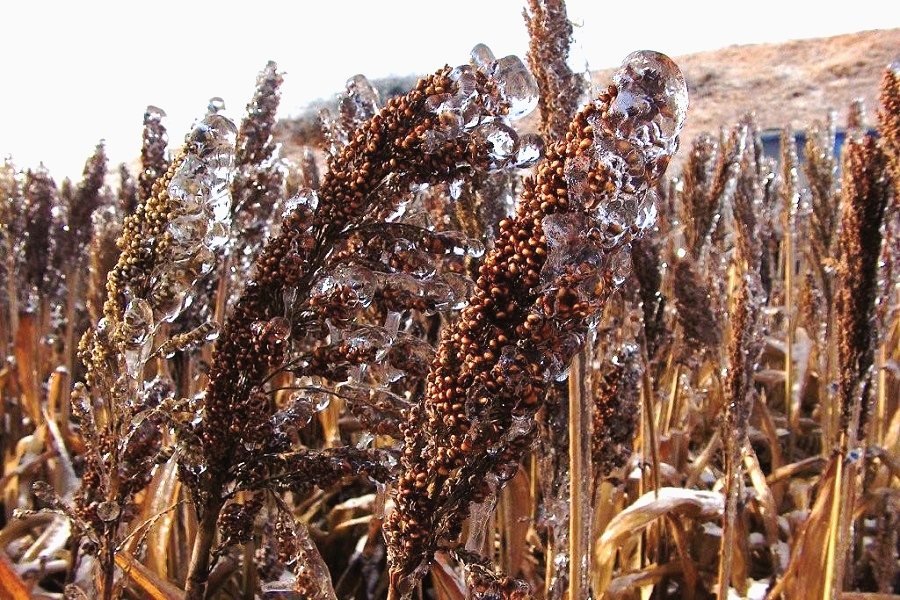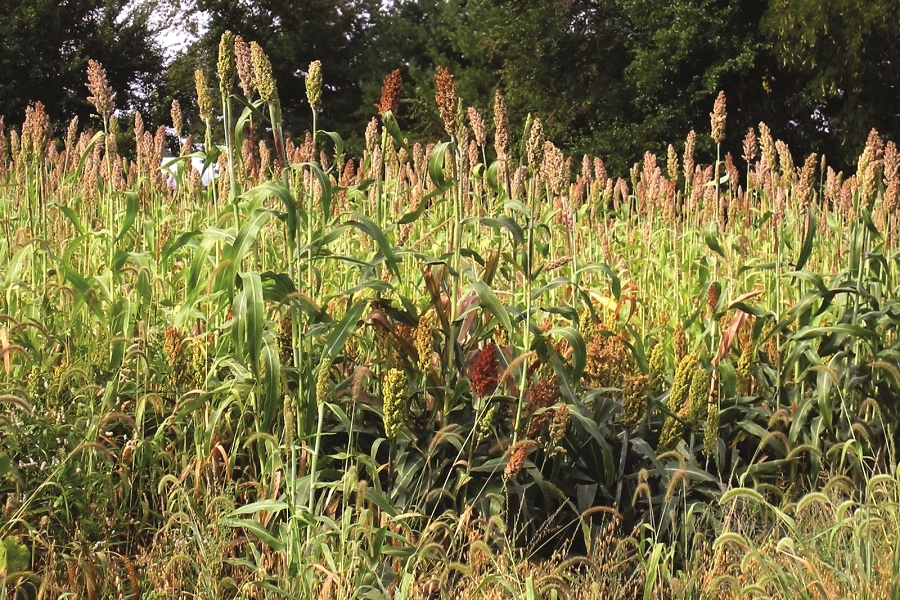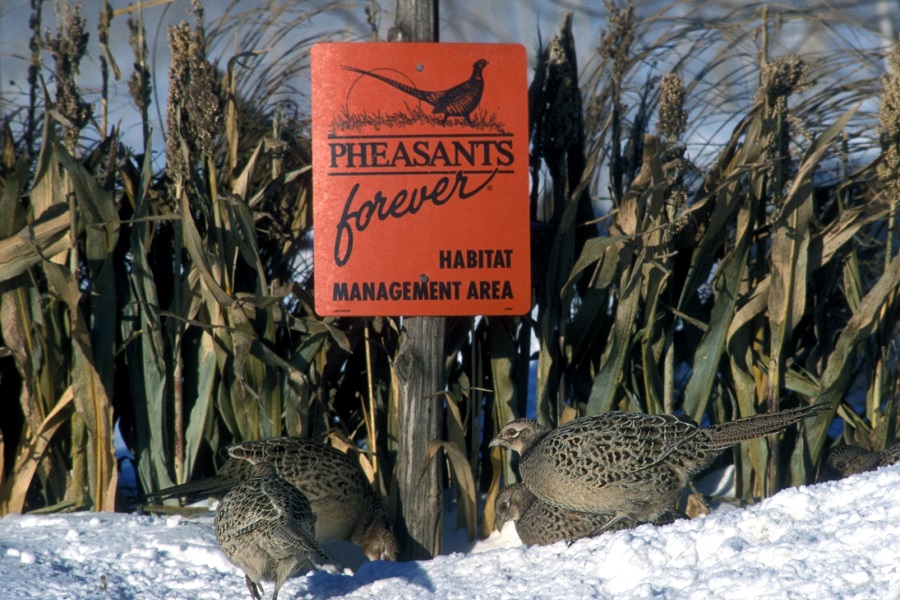Food plots can be established almost anywhere, but to maximize the impact for your local pheasant population, a little extra thought will go a long way. The answers to these commonly-asked
food plot questions will have you on your way to planting a pheasant-friendly food plot this spring.
Why do I need food plots on my land?
High-quality grain food plots play a critical role in the relationship between food, cover, movement, and winter pheasant mortality. The logic is simple: locating well-planned food and cover plots adjacent to heavy roosting cover provides a dependable source of high-energy food. Having food right next door to winter cover helps establish safe foraging patterns and minimizes movements. The result is reduced losses to predation and extreme weather.
How do I decide which seed mixes are right for my land?
Examine your habitat objectives for your land—what would you like to accomplish for wildlife, and what are your desires for hunting and wildlife viewing? Look particularly at winter food and cover conditions. If this habitat is limited, you will need grain food plots to assist game birds. You may benefit other wildlife by establishing browse plots as well.
Are specialized mixes worth the extra cost?
Seed cost will likely be the smallest expense in your overall food plot spending; yet, it is the foundation of your effort to improve food resources for wildlife, so buy the
very best seed that you can for your food plots.
- Grain-based food plots - Where primary winter cover is limited, planting grain-based mixes (like sorghum blends) will provide structural cover in addition to food. Creating larger plots adjacent to your primary wintering areas increases the character of that shelter for your birds. That helps you achieve your primary objective—to bring your hens through the winter in peak condition for spring breeding, as improved body weight helps maximize chick production.
- Browse mixes - Provide forage that will help attract big game to your land. In some cases, these mixes can also provide high-quality brood habitat for upland birds (a leafy, insect rich structure is important for game bird chicks).
 How large should my food plot be?
How large should my food plot be?
Unfortunately, we cannot predict when wildlife will most need supplemental winter food resources, so plan grain food plots for the worst case weather scenario each and every year. Don't create a project that will be buried by the first blizzard. Also, your food plots will be used by many kinds of wildlife. Deer and turkeys consume a lot of grain and will exhaust small food patches well before winter ends. Thus, larger food plots (3-10 acres) are always the most desirable. Select a food plot mix based on the cover and food values you need, and carefully assess the critical factors of size and location for your land.
What is the best design for my food plot?
Grain food plots should restrict unnecessary travel, as well as provide high quality food and supplemental winter cover. Birds crossing hostile territory for food invite losses from predation and weather, so two critical design factors include locating food plots next to winter cover and having an adequate sized food plot (3-4 acres or larger is best). Blocks will be preferable to linear plantings, and food plot placement on the windward side of winter cover improves that habitat. If winter cover is scarce, 10-acre plantings of grain mixes with heavy leaf structure can provide all the food and shelter that birds need. In general, green browse plots will not provide winter cover for most upland birds, but will provide foraging areas for deer.
When is the best time to plant?
Take cues from agricultural operations occurring in your area. This will give you a general idea when to plant, and look for more specific instructions on the bag.
 Do I have to use herbicides & fertilizer?
Do I have to use herbicides & fertilizer?
Weed competition is the most serious threat your food plot will face; thus, we recommend some sort of herbicide treatment. Food plots planted without weed control will have highly variable results. Weed problems can be addressed by tillage, chemical suppression, or a combination of both. A few weeds in a food plot will actually improve the diversity of the area for wildlife. However, severe weed competition that causes the primary planting to fail can waste your food plot investment and puts your wildlife in a bad position when winter arrives. Pay attention to weed control recommendations on the bag for best results.
Food plots are a crop, so you should fertilize just as you would your garden. You can easily assess the nutrients in your planting area before the planting season with a simple soil test—farm co-ops, and/or U.S. Department of Agriculture (USDA) offices routinely do this at a low cost. Be sure to amend the soil accordingly before you plant. Rotating grain food plots into areas previously established in legume browse may save money on nitrogen, but nearly all food plots need some supplemental nutrients. Legume food plots do not need nitrogen, but normally require some soil supplements to optimize the stand.
What about planting my plot?
Food plots can be established with standard planters, grain drills, or with broadcast seeders mounted on a tractor, ATV or pickup truck. Complete planting instruction are on each bag. If you don't have your own equipment, it can often be rented from USDA offices, local implement dealers and wildlife agencies.
 How long will my food plot last?
How long will my food plot last?
In general, a grain based food plot will last only a single season (particularly if deer use it heavily). Almost without fail, you will need to re-establish this kind of plot annually. In rare instances of low wildlife use, the grain from one year will carry over to the next on the stalks. Allowing a plot like this to grow up into annual weeds provides excellent brood habitat. Green browse food plots (blends of clovers, alfalfa, etc.) may last several years or may need to be re-planted each year (combination leafy forage/root crops like turnips).
What other factors should I consider?
Food plots alone are not going to "bring back the birds." Well-placed food plots can help bring more hens through winter in better condition. At that point, however, the other habitat you have established on your land (nesting cover, brood rearing habitat, etc.) will play the leading role. Be sure you focus on establishing and managing those important areas for wildlife as well.
By Jim Wooley, Pheasants Forever and Quail Forever field director and senior wildlife biologist (emeritus)
Photo credit: Main, first, and second images - Pheasants Forever file photos / fourth image by Roger Hill